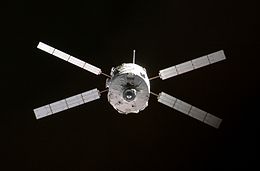 Jules Verne ATV on its approach to the International Space Station | |
| Mission type | ISS resupply |
|---|---|
| Operator | European Space Agency |
| COSPAR ID | 2008-008A |
| SATCAT no. | 32686 |
| Mission duration | 204 days, 9 hours, 28 minutes |
| Spacecraft properties | |
| Spacecraft type | Automated Transfer Vehicle |
| Manufacturer | EADS Astrium |
| Launch mass | 19,360 kg (42,680 lb) |
| Start of mission | |
| Launch date | 9 March 2008, 04:03 UTC |
| Rocket | Ariane 5ES |
| Launch site | Guiana, ELA-3 |
| Contractor | Arianespace |
| End of mission | |
| Disposal | Deorbited |
| Decay date | 29 September 2008, 13:31 UTC |
| Orbital parameters | |
| Reference system | Geocentric |
| Regime | Low Earth |
| Perigee altitude | 331 km (206 mi) |
| Apogee altitude | 339 km (211 mi) |
| Inclination | 51.6° |
| Period | 91.34 minutes |
| Docking with ISS | |
| Docking port | Zvezda aft |
| Docking date | 3 April 2008, 14:45 UTC |
| Undocking date | 5 September 2008, 21:29 UTC |
| Time docked | 155 days, 6 hours, 44 minutes |
| Cargo | |
| Mass | 2,297 kg (5,064 lb) |
| Pressurised | 1,150 kg (2,540 lb) |
| Fuel | 856 kg (1,887 lb) |
| Gaseous | 21 kg (46 lb) |
| Water | 270 kg (600 lb) |
The Jules Verne ATV, or Automated Transfer Vehicle 1 (ATV-1), was a robotic cargo spacecraft launched by the European Space Agency (ESA). The ATV was named after the 19th-century French science-fiction author Jules Verne.[1] It was launched on 9 March 2008 on a mission to supply the International Space Station (ISS) with propellant, water, air, and dry cargo. Jules Verne was the first of five Automated Transfer Vehicle spacecraft to be launched.
Because it was the first ATV to be launched, Jules Verne underwent three weeks of orbital testing before beginning its final rendezvous with the ISS. The spacecraft docked to the ISS on 3 April 2008 to deliver its cargo. On 25 April 2008, Jules Verne used its thrusters to reboost the station into a higher orbit.[2] After spending just over five months docked at the station, Jules Verne undocked on 5 September 2008 and made a destructive re-entry over the Pacific Ocean on 29 September.[3]
- ^ "Europe's 'Jules Verne' spacecraft carries namesake's notes on maiden voyage". collectSPACE. 7 March 2008. Retrieved 9 March 2008.
- ^ "Jules Verne boosts ISS orbit". ESA – ATV. 25 April 2008. Retrieved 26 April 2008.
- ^ "International success for Astrium: Europe's Jules Verne mission accomplished". EADS. 29 September 2008. Archived from the original on 2010-02-02.